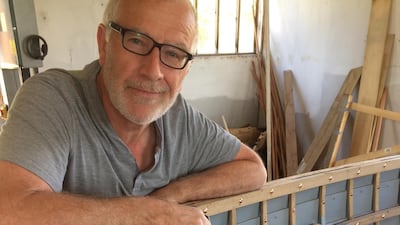Jonathan Gornall’s book begins with a light-hearted quip about there being only two ways to find out if a wooden boat is seaworthy: “One is to put it in the water and see if it sinks. The other is to keep it on dry land, fill it with water and see if it leaks ... which is why I am now standing, heart in mouth, hosepipe in hand.”
The anecdote quickly confirms that How To Build A Boat is not the project guide its title might suggest. In fairness, the exquisitely illustrated cover also strongly suggests the book is more of a memoir than an instruction manual. A Haynes practical volume this is not.
Gornall’s text leans heavily on allegory. He is not just building a small wooden boat from scratch, but making sense of his life and his relationships with his wife, his preschool daughter, his 30-something son and his late mother. It is a complex and rewarding book of modern families and traditional skills.
The author is a former staff member of this newspaper. He arrived in the UAE in 2008 and returned to the UK in 2012, driven to relocate back to his home country by two life-changing events.
He had rekindled in the later months of the previous year a relationship with a “past love”, Kate, in England, and by the end of 2011, after four years in the Gulf and approaching his late 50s, he had hatched a plan to move back to the UK, “scale back my career as a journalist, abandon shore-based living for good and invest my modest gains in a small but sea-friendly wooden boat”.
His best-laid plans ran aground before he had a chance to leave the UAE, when a routine medical check-up revealed familial hypercholesterolaemia, a genetic defect that Gornall writes “starts lining the arteries with gunk from an early age”. He underwent an emergency multiple coronary artery bypass in Dubai Healthcare City within days.
Within weeks he was back in the UK and within months he had married Kate. Their daughter Phoebe was born in April 2014.
Gornall's understanding of his great escape from a significant health scare and the serendipitous second chance his marriage to Kate and Phoebe's arrival offer him – a "beautiful, exhausting and exhilarating late-life surprise" – convinces him to want to build a boat.
It is not the most obvious conclusion to draw from such circumstances, but as he explained to this newspaper’s readers last year, he decided to do so “partly as a gift and a life lesson to my daughter ... but also I did it for me. I wanted to see if a thoroughly unskilled modern man could do such a thing. Could I, with my soft hands and my digital, screen-framed existence, create a traditional, clinker-built boat, wrought from trees that sprang from the earth long before my grandfather was born?”
Strong elements of both destiny and discovery drive the book forward. It is a volume crying out to be made into a film, with its narrative threads of redemption, love and thoughtful craftsmanship asking to be knitted together in a screenplay.
Gornall's text also brings to mind the final words of F Scott Fitzgerald's The Great Gatsby – "So we beat on, boats against the current, borne back ceaselessly into the past" – as How To Build A Boat settles into a pattern of pushing on with the project while trying to reconcile with the past. Some of this makes for painful reading, both in the construction of the wooden craft and in the frank deconstruction of his life.
The author describes building the boat as “hot, frustrating work, hand-to-hand combat with history and tradition”. It is “an unmitigated struggle” from first plank to last. Used to the quick-hit of life as a freelance journalist – research, write, file, invoice, repeat – the laborious process of boat-building befuddles the author. He is, he concedes, “the very definition of the bad workman blaming his tools”.
In the solitude of his work space, Gornall assesses the fragments of his relationship with his late mother (“there was a clear understanding while I was growing up that I had ruined my mother’s life”) as he pieces the boat together. Similarly, he chides himself for not being the father he feels he should have been to Adam, his grown-up son (“the thought of having turned my back on my two-year-old son all those years ago filled me with deep shame and regret”). It’s tough, honest writing made a little easier to read by Gornall’s comfortable way with words.
Fear of failure haunts the author as the build progresses. Acutely aware that this is a vanity project, a professional would need about 300 hours to complete what will take Gornall about a year to finish, he frets about balancing the demands of his self-imposed task with raising a family and the more mundane business of paying the mortgage. He builds the boat by day and burns the midnight oil writing for, among others, this newspaper. He calls it a “perilous, high-wire business” and sometimes he falls off.
What started out as a romantic adventure is partly exposed as a leap of potentially ruinous faith. It doesn’t help that Phoebe, Gornall’s “North Star”, isn’t quite as on board with the whole idea as her father. She worries that the boat might sink. It is no spoiler alert to say she is won over in the end.
Gornall also unpicks the two attempts he made to row the Atlantic years earlier, which cast long shadows over his life and the boat-building project he is now so desperate to complete.
__________________________
Read more:
Book review: Barbara J King asks where do we draw the line with what we eat?
Book review: A laugh-out-loud account of how 'The Simpsons' came to be
Book review: Ben White's Cracks in the Wall looks at Israel in isolation
__________________________
The first time, as part of a pair in 2001, ended in defeat after 47 days at sea. The second attempt, as one of a crew of four in 2004, was undone by a storm just a few hundred miles away from completing their crossing. There is no shame in either eventuality, but Gornall’s long-term memory has settled on a single comment from Rob Hammill, who won the Atlantic Rowing Race in 1997 and tried unsuccessfully to persuade the author to carry on in 2001 just before he quit: “Pain is just for now. Failure lasts forever”. Those words light his way towards completing the boat. Giving up on this task, the author concludes, is out of the question.
Throughout the build, Gornall calls upon the services of Fabian Bush, a boat builder of some note, who offers advice and brings fruit cake on his visits to the workshop. Bush is largely there as an observer and as a mentor, offering counsel rather than being overly interventionist.
That explains why the boat that Gornall completes is "a charming collaboration of imperfections". It's named Swift, a reference to the birds that swoop around Gornall in the English countryside and, perhaps, a subtle jibe at the slow, methodical commitment required to build such a thing.
But neither Swift nor its creator is the star of the piece. That status belongs to Phoebe, the recipient of a "vessel for a father's love" and the person who succeeded in calming the once choppy waters of the author's life.




